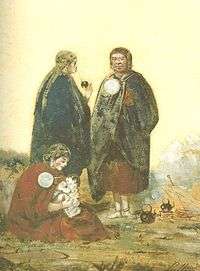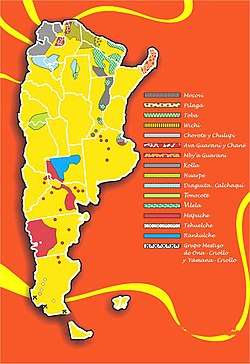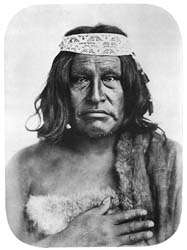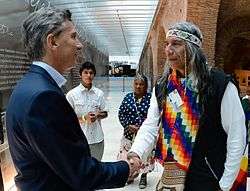Indigenous peoples in Argentina
Argentina has 35 indigenous groups (often referred to as Argentine Amerindians or Native Argentines) according to the Complementary Survey of the Indigenous Peoples of 2004,[2] the Argentine government's first attempt in nearly 100 years to recognize and classify the population according to ethnicity. In the survey, based on self-identification or self-ascription, around 600,000 Argentines declared to be Amerindian or first-generation descendants of Amerindians, that is, 1.49% of the population.[2] The most populous indigenous groups were the Aonikenk, Kolla, Qom, Wichí, Diaguita, Mocoví, Huarpe peoples, Mapuche and Guarani[2] In the 2010 census [INDEC], 955,032 Argentines declared to be Amerindian or first-generation descendants of Amerindians, that is, 2.38% of the population.[1] Many Argentines also identify as having at least one indigenous ancestor; a genetic study conducted by the University of Buenos Aires in 2011 showed that more than 56% of the 320 Argentines sampled were shown to have at least one indigenous ancestor in one parental lineage and around 11% had indigenous ancestors in both parental lineages.[3]
 Pampas peoples | |
| Total population | |
|---|---|
| 955,032 2.38% of the Argentine Population[1] | |
| Regions with significant populations | |
| Argentine Northwest | |
| Languages | |
| Spanish • Several Indigenous languages such as Qom, Wichi, Quechua, Mapuche, etc. |

Jujuy Province, in the Argentine Northwest, is home to the highest percentage of households (15%) with at least one indigenous resident or a direct descendant of an indigenous person; Chubut and Neuquén Provinces, in Patagonia, have upwards of 12%.[4]
Prehistory
The earliest known evidence of indigenous peoples in Argentina is dated 11,000 BC[5] and was discovered in what now known as the Piedra Museo archaeological site in Santa Cruz Province. The Cueva de las Manos, also in Santa Cruz, is over 10,000 years old.[6] Both are among the oldest evidence of indigenous culture in the Americas, and have, with a number of similarly ancient sites on other parts of the southern hemisphere, challenged the "Clovis First" hypothesis on the settlement of the Americas (the assumption, based on lacking evidence to the contrary, that the Clovis culture was the first in the Western Hemisphere).[7]
History
By the year 1500, many different indigenous communities lived in what is now modern Argentina. They were not a unified group but many independent ones, with distinct languages, societies, and relations with each other. As a result, they did not face the arrival of the Spanish colonization as a single block and had varied reactions toward the Europeans. The Spanish people looked down on the indigenous population, to the point that they held in doubt whether they had souls, following the general thought in Europe. For this reason, they kept very little historical information about them.[8]

In the 19th century major population movements altered the original Patagonian demography. Between 1820 and 1850 the original Aonikenk people were conquered and expelled from their territories by invading Mapuche (that called them Tehuelches) armies. By 1870 most of northern Patagonia and the south east Pampas were Araucanized.[9] During the Generation of 1880, European immigration was strongly encouraged as a way of occupying an empty territory, configuring the national population and, through their colonizing effort, gradually incorporating the nation into the world market. These changes were perhaps best summarized by the anthropological metaphor which states that “Argentines descend from ships.”[10] The strength of the immigration and its contribution to the Argentine ethnography is evident by observing that Argentina became the second country in the world that received the most immigrants, with 6.6 million, second only to the United States with 27 million, and ahead of countries such as Canada, Brazil, Australia, etc.[11][12]
The expansion of European immigrant communities and the railways westward into the Pampas and south into Patagonia was met with Malón raids by displaced tribes. This led to the Conquest of the Desert in the 1870s, which resulted in over 1,300 indigenous dead.[13][14] Indigenous cultures in Argentina were consequently affected by a process of invisibilization, promoted by the government during the second half of the 19th century and the early 20th.[15]
The extensive explorations, research and writing by Juan Bautista Ambrosetti and other ethnographers during the 20th century, which followed earlier pioneer studies by anthropologists such as Robert Lehmann-Nitsche,[16] encouraged wider interest in indigenous people in Argentina, and their contributions to the nation's culture were further underscored during the administration of President Juan Perón in the 1940s and 1950s as part of the rustic criollo culture and values exalted by Perón during that era.[17] Discriminatory policies toward these people and other minorities officially ended, moreover, with the August 3, 1988, enactment of the Antidiscrimination Law (Law 23.592) by President Raúl Alfonsín,[18] and were countered further with the establishment of a government bureau, the National Institute Against Discrimination, Xenophobia, and Racism (INADI), in 1995.[19] Corrientes Province, in 2004, became the first in the nation to award an indigenous language (Guaraní) with co-official status,[20] and all 35 native peoples were recognized by both the 2004 Indigenous Peoples Census and by their inclusion as self-descriptive categories in the 2010 census; indigenous communities and Afro-Argentines thus became the only groups accorded any recognition as ethnic categories by the 2010 census.[21]
Demographics

In addition to the indigenous population in Argentina, most Argentines are descendants of indigenous peoples or have some indigenous ancestry. Many genetic studies have shown that Argentina's genetic footprint is primarily but not overwhelmingly European. In a genetic study involving 441 Argentines from across the North East, North West, Southern, and Central provinces (especially the urban conglomeration of Buenos Aires) of the country, it was observed that 65% of the Argentine population was of European descent, followed by 31% of Amerindian descent, and 4% of African descent.[22] It was also found there were great differences in the ancestry amongst Argentines as one traveled across the country.
For example, the population in the North West provinces of Argentina (includes the province of Salta) were on average of 66% Amerindian, 33% European, and 1% of African ancestry.[22] The European immigration to this North West part of the country was limited and the original Amerindian population largely thrived after their initial decline owing to the introduction of European diseases and colonization.
Similarly, the study also showed that the population in the North Eastern provinces of Argentina (for example, Misiones, Chaco, Corrientes, and Formosa) were on average 43% of Amerindian, 54% European, and 3% of African ancestry.[22] The population of the Southern provinces of Argentina, such as Rio Negro and Neuquen, were on average 40% of Amerindian, 54% European, and 6% of African ancestry.[22] Finally, only in areas of massive historical European immigration in Argentina, namely the Central provinces, Buenos Aires and the surrounding urban areas, were Argentines of overwhelmingly European ancestry, with the average person having 17% Amerindian, 76% European, and 7% of African ancestry.[22]
In another study, that was titled the Regional pattern of genetic admixture in South America, the researchers included results from the genetic study of several hundreds of Argentines from all across the country. The study indicated that Argentines were as a whole made up of 38% Amerindian, 58.9% of European, and 3.1% of African ancestry. Again, there were huge difference in the genetic ancestry from across the various regions of the country.[23] For example, Argentines who hailed from Patagonia were 45% Amerindian and 55% of European ancestry .[23] The population in the North West part of the country were made up of 69% of Amerindian, 23% of European, and 8% of African ancestry.[23] The population in the Gran Chaco part of the country were 38% of Amerindian, 53% of European, and 9% of African ancestry.[23] The population in the Mesopotamian part of the country were 31% of Amerindian, 63% of European, and 6.4% of African ancestry.[23] Finally, the population in the Pampa region of the country were 22% of Amerindian, 68% of European, and 10% of African ancestry.[23]
Finally in another study involving the North Western provinces of the country, a total of 1293 individuals from Jujuy, Salta, Tucumán, Santiago del Estero, Catamarca and La Rioja were used.[24] This study showed that the Spanish contribution (50%) predominated in Argentina's North West, followed by the American Indian (40%) and African (10%) contributions.[24] According to this study, Argentines from Jujuy were 53% Amerindian, 47% European, and 0.1% African ancestry.[24] Argentines from Salta were 41% of Amerindian, 56% of European, and 3.1% of African ancestry.[24] Those from Catamarca were 37% of Amerindian, 53% of European, and 10% of African ancestry.[24] Those from La Rioja were on average 31% Amerindian, 50% European, and 19% African ancestry.[24] The inhabitants of Santiago del Estero were on average 30% Amerindian, 46% European, and 24% African ancestry.[24] The inhabitants of Tucuman were on average 24% Amerindian, 67% European, and 9% African ancestry.[24]
Indigenous communities today

Argentina has a total population of 40 million. The Additional Survey on Indigenous Populations, published by the National Institute for Statistics and Census, gives a total of 600,329 people who see themselves as descending from or belonging to indigenous people.[25]
For a number of reasons the different indigenous organisations do not believe this to be a credible survey: First, the methodology used in the survey was considered inadequate, as a large number of indigenous people live in urban areas where the survey was not fully conducted. Second, many indigenous people in the country hide their identity for fear of discrimination. Moreover, when the survey was designed in 2001, it was based on the existence of 18 known peoples in the country, today there exist more than 31 groups. This increase reflects a growing awareness amongst indigenous people in terms of their ethnic belonging.[25]
As many Argentines either believe that the majority of the indigenous have died out or are on the verge of doing so, or 'their descendants' assimilated into Western civilisation many years ago, they wrongly hold the idea that there are no indigenous people in their country. The use of pejorative terms likening the indigenous to lazy, idle, dirty, ignorant and savage are part of the everyday language in Argentina. Due to these incorrect stereotypes many indigenous have over the years been forced to hide their identity in order to avoid being subjected to racial discrimination.[25]
As of 2011 many natives were still being denied land and human rights. Many of the Qom native community had been struggling to protect the land they claim as ancestral territory and even the lives of its members. A leader of the Aboriginal Community Félix Díaz claimed that his people were being denied medical assistance, did not have much access to drinking water and traders keep raising food prices. He also claimed judges would not even hear the native's complaints.[26]
Indigenous groups by population
According to the 2010 census there are the following indigenous groups:[1]
| Indigenous group | Total population | Males | Females |
|---|---|---|---|
| Mapuche | 205,009 | 103,253 | 101,756 |
| Toba | 126,967 | 63,772 | 63,195 |
| Guaraní | 105,907 | 53,788 | 52,119 |
| Diaguita | 67,410 | 34,295 | 33,115 |
| Kolla | 65,066 | 32,553 | 32,513 |
| Quechua | 55,493 | 27,849 | 27,644 |
| Wichí | 50,419 | 25,513 | 24,906 |
| Comechingón | 34,546 | 17,077 | 17,469 |
| Huarpe | 34,279 | 17,098 | 17,181 |
| Tehuelche | 27,813 | 13,948 | 13,865 |
| Mocoví | 22,439 | 11,498 | 10,941 |
| Pampa | 22,020 | 10,596 | 11,424 |
| Aymara | 20,822 | 10,540 | 10,282 |
| Avá Guaraní | 17,899 | 9,438 | 8,461 |
| Rankulche | 14,860 | 7,411 | 7,449 |
| Charrúa | 14,649 | 7,192 | 7,457 |
| Atacama | 13,936 | 7,095 | 6,841 |
| Mbya-Guaraní | 7,379 | 3,872 | 3,507 |
| Omaguaca | 6,873 | 3,551 | 3,322 |
| Pilagá | 5,137 | 2,623 | 2,514 |
| Tonocote | 4,853 | 2,437 | 2,416 |
| Lulé | 3,721 | 1,918 | 1,803 |
| Tupí Guaraní | 3,715 | 1,872 | 1,843 |
| Querandí | 3,658 | 1,776 | 1,882 |
| Chané | 3,034 | 1,559 | 1,475 |
| Sanavirón | 2,871 | 1,399 | 1,472 |
| Ona | 2,761 | 1,383 | 1,378 |
| Chorote | 2,270 | 1,177 | 1,093 |
| Maimará | 1,899 | 876 | 1,023 |
| Chulupi | 1,100 | 537 | 563 |
| Vilela | 519 | 279 | 240 |
| Tapiete | 407 | 217 | 189 |
| Others | 5,301 | 2,681 | 2,620 |
| Total | 955,032 | 481,074 | 473,958 |
Indigenous groups by region
Northeast
| Historical states in present-day Argentina |
|---|
|
before 1500
|
|
1500–1600
|
|
1600–1700
|
|
1700–1800
|
|
1800–1830
|
|
1830–present
|
| more |
This region includes the provinces of Chaco, Corrientes, Entre Ríos, Formosa, Misiones, Santa Fe, and parts of Santiago del Estero Province.
Northwest
This region includes the provinces of Catamarca, Jujuy, La Rioja, Salta, San Juan, parts of Santiago del Estero Province, and Tucumán.
- Atacama
- Avá-Guaraní
- Chané
- Chorote
- Chulupí
- Diaguita-Calchaquí
- Kolla
- Ocloya
- Omaguaca
- Tapiete
- Qom
- Wichí[25]
- Quechua
Central
This region includes the Autonomous City of Buenos Aires and the provinces of Buenos Aires, Córdoba, La Pampa, Mendoza, and San Luis.
- Atacama
- Avá Guaraní
- Comechingon
- Diaguita-Calchaquí
- Huarpe
- Kolla
- Mapuche
- Het
- Rankulche[25]
South
This region includes the provinces of Chubut, Neuquén, Río Negro, Santa Cruz, and Tierra del Fuego.
See also
- Indigenous peoples of South America
- Languages of Argentina
- Argentine people
- Abipón people
- Amaicha
- Calchaquí
- Capayán
- Poya people
Notes
- "Censo Nacional de Población, Hogares y Viviendas 2010: Pueblos Originarios: Región Noroeste Argentino: Serie D No 1" (PDF) (in Spanish). INDEC. Archived from the original (PDF) on 9 April 2016. Retrieved 5 December 2015.
- "Encuesta Complementaria de Pueblos Indígenas". Archived from the original on 2008-06-11. Retrieved 2008-06-18.
- Archived 2011-08-20 at the Wayback MachineEstructura genética de la Argentina, Impacto de contribuciones genéticas - Ministerio de Educación de Ciencia y Tecnología de la Nación
- Indec. Porcentaje de hogares por provincia que se reconoce descendiente de un pueblo indígena (in Spanish)
- Welcome Argentina: Expediciones Arqueológicas en Los Toldos y en Piedra Museo (in Spanish)
- Cueva de las Manos. UNESCO WHC website.
- Smithsonian: Paleoamerican Origins
- Galasso 111-112
- Neuquén: Los pueblos originarios y los posteriores part I, part II
- Trinchero, Héctor Hugo (2006). "The genocide of indigenous peoples in the formation of the Argentine Nation-State". Journal of Genocide Research. 8 (2): 121–35. doi:10.1080/14623520600703008.
- "Argentina Desert War 1879–1880". Onwar.com. 2003. Archived from the original on 2011-01-12. Retrieved 2011-04-29.
- Jens Andermann. "Argentine Literature and the 'Conquest of the Desert', 1872–1896". Birkbeck, University of London. Retrieved 2009-09-02.
- Bartolomé, Miguel Alberto (2003). "Los pobladores del 'desierto' Genocidio, etnocidio y etnogénesis en la Argentina" [The inhabitants of the 'desert' genocide, ethnocide and ethnogenesis in Argentina]. Cuadernos de Antropología Social (in Spanish). 17 (1): 162–89.
- Ballestero, Diego (2013). Los espacios de la antropología en la obra de Robert Lehmann-Nitsche, 1894-1938 (PhD). Universidad Nacional de La Plata.
- Karush, Matthew; Chamosa, Oscar (2010). The New Cultural History of Peronism: Power and Identity in Mid-Twentieth Century. Duke University Press. ISBN 0822392860.
- Ley 23.592 Antidiscriminatoria (in Spanish)
- Sitio oficial del instituto Nacional contra la Discriminación (INADI) Archived 2011-03-14 at the Wayback Machine (in Spanish)
- Ley Provincial Nº 5.598, Corrientes Archived 2012-02-29 at the Wayback Machine (in Spanish)
- INDEC. Censo 2010. (in Spanish)
- Avena, Sergio; Via, Marc; Ziv, Elad; Pérez-Stable, Eliseo J.; Gignoux, Christopher R.; Dejean, Cristina; Huntsman, Scott; Torres-Mejía, Gabriela; et al. (2012). Kivisild, Toomas (ed.). "Heterogeneity in Genetic Admixture across Different Regions of Argentina". PLoS ONE. 7 (4): e34695. doi:10.1371/journal.pone.0034695. PMC 3323559. PMID 22506044.
- Godinho, N.M.O.; Gontijo, C.C.; Diniz, M.E.C.G.; Falcão-Alencar, G.; Dalton, G.C.; Amorim, C.E.G.; Barcelos, R.S.S.; Klautau-Guimarães, M.N.; Oliveira, S.F. (2008). "Regional patterns of genetic admixture in South America". Forensic Science International: Genetics Supplement Series. 1 (1): 329–30. doi:10.1016/j.fsigss.2007.10.069.
- Alfaro, E. L.; Dipierri, J. E.; Gutiérrez, N. I.; Vullo, C. M. (2005). "Genetic structure and admixture in urban populations of the Argentine North-West". Annals of Human Biology. 32 (6): 724–37. doi:10.1080/03014460500287861. PMID 16418046.
- "Indigenous Peoples in Argentina". International Work Group for Indigenous Affairs. Retrieved June 9, 2013.
- "'Native American rights widely abused'". PressTV. 12 August 2011. Archived from the original on 5 March 2016. Retrieved 30 March 2013.
References
- Galasso, Norberto (2011). Historia de la Argentina. Argentina: Colihue. ISBN 978-950-563-478-1.
External links
| Wikimedia Commons has media related to Indigenous peoples of Argentina. |
- About Argentina: Indigenous Population, Argentine government website
.svg.png)